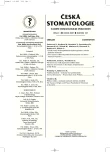I. Thin Layers of Biocompatible Hydroxyapatite and Zircon – Physical Properties
Authors:
Z. Teuberová 1; M. Seydlová 1; T. Dostálová 1; B. Dvořánková 2; K. Smetana Jr. 2; M. Jelínek 3; P. Mašínová 3; T. Kocourek 3; K. Kolářová 4; J. Wilson 5
Authors‘ workplace:
Protetické oddělení, Stomatologická klinika 1. LF UK, Praha
1; Anatomický ústav, 1. LF UK, Praha
2; Fyzikální ústav AV ČR, Praha
3; Ústav inženýrství pevných látek
Vysoká škola chemicko-technologická, Praha
4; Fakulta nukleárních věd a fyzikálního inženýrství
Česká technická univerzita, Praha
5
Published in:
Česká stomatologie / Praktické zubní lékařství, ročník 107, 2007, 1, s. 5-9
Overview
Summary:
This study examined the mechanical and biological properties of titanium alloy implant cores with a buffer layer from zirconia and a coating of hydroxyapatite created with pulsed laser deposition (PLD). The thickness of the zirconia layer was 50 – 100 nm and the hydroxyapatite layer ~600 nm. We measured crystallinity, morphology, wettability and Ca/P ratio of the hydroxyapatite layer. The methods used for physical evaluation were electron microscopy, X-ray diffraction, goniometric measurement of contact angle and wavelength dispersive X-ray analysis. The physical tests summarized good mechanical properties and a satisfactory adhesion to a titanium core modified with zirconia and hydroxyapatite. PLD was found to be a promising method of applying thin films to a metal core for dental implants.
Key words:
dentistry – dental implant – coating – pulsed laser deposition – hydroxyapatite – zirconia
Labels
Maxillofacial surgery Orthodontics Dental medicineArticle was published in
Czech Dental Journal

2007 Issue 1
Most read in this issue
- Internal Granuloma – Present State of the Problem
- What is the Silicon Matrix?
- Direct Applications of Fiber. Composites Substitution of Missing Frontal Teeth
- The Causes of Origin and Present Possibility for Treatment of Alveolitis (A Review)
